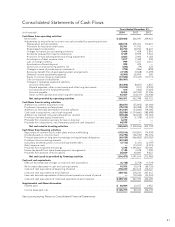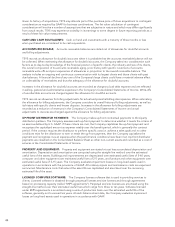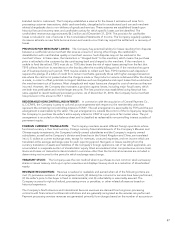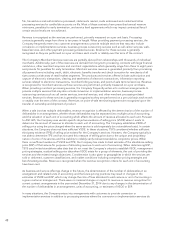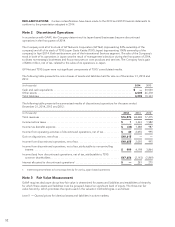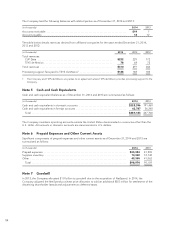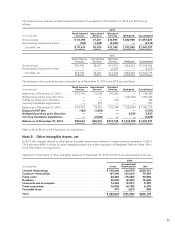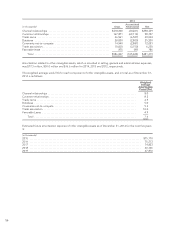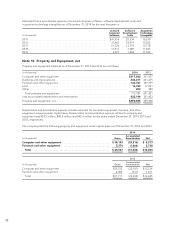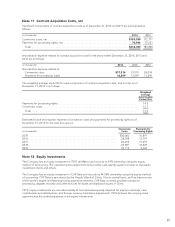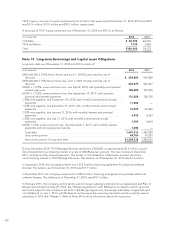NetSpend 2014 Annual Report Download - page 54
Download and view the complete annual report
Please find page 54 of the 2014 NetSpend annual report below. You can navigate through the pages in the report by either clicking on the pages listed below, or by using the keyword search tool below to find specific information within the annual report.ADVERTISING: Advertising costs are expensed as incurred or the first time the advertising takes place except
for direct-response advertising and television advertising production costs. Direct-response advertising consists
of commission paid to affiliate marketers for the new funded customer accounts generated by them.
Direct-response advertising costs are capitalized and amortized over the average life of the new accounts, which
is approximately one year. Television advertising production costs consist of the costs of developing and filming
television ads. Television advertising production costs are capitalized when the production services are received
and expensed in the period when the advertising first takes place. Advertising expense for 2014, 2013 and 2012
was $5.7 million, $1.3 million and $1.0 million, respectively.
INCOME TAXES: Income taxes reflected in TSYS’ consolidated financial statements are computed based on
the taxable income of TSYS and its affiliated subsidiaries. A consolidated U.S. federal income tax return is filed for
TSYS and its majority- owned U.S. subsidiaries. Additionally, income tax returns are also filed in states where
TSYS and its subsidiaries have filing obligations and in foreign jurisdictions where TSYS has a foreign affiliate.
The Company accounts for income taxes in accordance with the asset and liability method. Deferred income tax
assets and liabilities are recognized for the future tax consequences attributable to differences between the
financial statement carrying amounts of existing assets and liabilities and their respective tax basis and operating
loss and tax credit carry forwards. Deferred tax assets and liabilities are measured using enacted tax rates expected
to apply to taxable income in the years in which those temporary differences are expected to be recovered or
settled. Reserves against the carrying value of a deferred tax asset are established when necessary to reflect the
decreased likelihood of realization of a deferred asset in the future. The effect on deferred income tax assets and
liabilities of a change in tax rates is recognized in income in the period that includes the enactment date.
Income tax provisions require the use of management judgments, which are subject to challenge by various
taxing authorities. Contingency reserves are periodically established where the amount of the contingency can be
reasonably determined and is likely to occur. Reductions in contingency reserves are recognized when tax
disputes are settled or examination periods lapse.
Significant estimates used in accounting for income taxes relate to the determination of taxable income, the
determination of temporary differences between book and tax basis, as well as estimates on the realizability of
tax credits and net operating losses.
TSYS recognizes potential interest and penalties related to the underpayment of income taxes as income tax
expense in the Consolidated Statements of Income.
NONCONTROLLING INTEREST: Noncontrolling interest in earnings of subsidiaries represents the minority
shareholders’ share of the net income or loss of TSYS Managed Services EMEA Ltd. (TSYS Managed Services) and
CPAY. The noncontrolling interest in the Consolidated Balance Sheet reflects the original investment by these
shareholders in TSYS Managed Services and CPAY, their proportional share of the earnings or losses and their
proportional share of net gains or losses resulting from the currency translation of assets and liabilities of TSYS
Managed Services and CPAY. TSYS has adopted the accounting policy to recognize gains or losses on equity
transactions of a subsidiary as a capital transaction.
EARNINGS PER SHARE: Unvested share-based payment awards that contain nonforfeitable rights to dividends
or dividend equivalents are “participating securities” as defined by GAAP, and therefore should be included in
EPS using the two-class method.
The two-class method is an earnings allocation method for computing EPS when an entity’s capital structure
includes two or more classes of common stock or common stock and participating securities. It determines EPS
based on dividends declared on common stock and participating securities and participation rights of
participating securities in any undistributed earnings.
Basic EPS is calculated by dividing net income by the weighted average number of common shares outstanding
during the period. Diluted EPS is calculated to reflect the potential dilution that would occur if stock options or
other contracts to issue common stock were exercised. Diluted EPS is calculated by dividing net income by
weighted average common and common equivalent shares outstanding. Common equivalent shares are
calculated using the treasury stock method.
51


